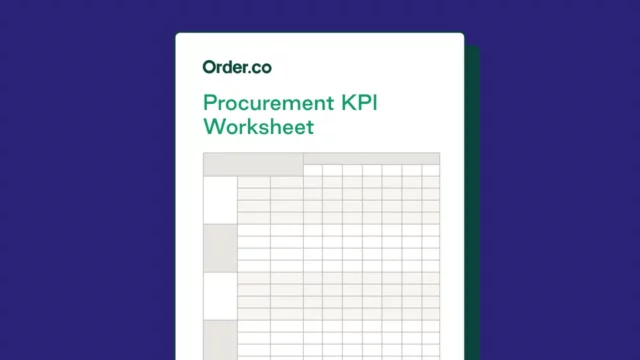Improve Your Procurement Process by Following These Steps

Improve Your Procurement Process by Following These Steps
Procurement can get cumbersome as companies grow. As the number of vendors and invoices increases, managing everything in a spreadsheet becomes inefficient and error-prone. To stay ahead, you need a reliable, scalable system.
But where do you start? And how can you make sure your procurement process actually delivers results?
This article covers the most important aspects of a solid, repeatable process. You'll find practical guidance on managing expenses, avoiding pitfalls, and strengthening your procurement process. You'll also learn which KPIs offer the clearest insights into your procurement performance.
Download the free tool: Procurement KPI Tracker Template
What is procurement?
Procurement means sourcing, buying, and paying for the supplies your company needs. It’s a mission-critical business activity that helps you run efficiently while keeping your staff productive and effective.
Good procurement management is a cost-saving measure, too. It helps you save money through strategic buying, optimize payment processes to improve buyer relationships, and shorten ordering and delivery cycles.
Difference between indirect, direct, and service procurement
Most businesses rely on three types of procurement. Each calls for different methods of cost control and management:
- Direct procurement: Purchases tied to production, including raw materials, equipment, resale items, or other manufacturing supplies
- Indirect procurement: Goods that don’t tie back to a specific product, like office supplies, fixed assets (desks and computers), facilities management items, and software tools
- Service procurement: Hired services that support direct or indirect business needs, such as legal support, contract-based workers, and managed services like security, IT, or facilities
The 3 stages of the procurement process
Procurement is an end-to-end process with three distinct phases:
- Sourcing: Identifying a need, looking for a product or service to fulfill it, and selecting the supplier that's the best fit
- Purchasing: The actual “buying” part of procurement, where you negotiate with a supplier, submit the order, receive the goods or services, and rate delivery quality and compliance
- Payment: Finalizing the transaction through reconciliation tasks like three-way matching (between the invoice, PO, and requisition), approving the invoice for payment, and issuing payments according to agreed-upon terms
10 steps in a successful procurement process
Most procurement systems follow a simple progression of awareness, selection, and completion. Follow these 10 basic steps to ensure visibility, control, and efficiency in every order:
1. Outline your product needs
Define what you need, such as office supplies, equipment, or software, and specify required features, quantities, and your anticipated budget. Clear parameters help create a solid foundation for an effective procurement process.
2. Submit a purchase requisition
Fill out a purchase requisition or intake form with the requirements you identified in step one. This formal purchase request should include all the necessary details to source, order, and pay for the goods.
Depending on the purchase, you might also suggest a few options for potential suppliers. For instance, if it’s for software, you could include three tools for the procurement team to evaluate.
3. Get the green light from departmental approvers
Route the order through a well-defined, departmental approval process, which may include department heads, legal, IT, or security teams. These approvers help ensure the purchase meets compliance, policy, and security standards.
This step is especially important when working with new suppliers.
4. Receive sign-off from Finance
Once department approvals are complete, send the request to the finance team for final approval. For small or one-off needs, they may authorize a spot buy and allow you to place the order. For larger, contract-based purchases, the finance or procurement department may take over to handle contract negotiations.
5. Put out a request for quotation (RFQ) for large purchases
For large or strategic purchases, such as high-volume goods, consulting services, or software, prepare an RFQ or RFP (request for proposal) to solicit competitive bids. This approach, sometimes called “three bids and a buy,” lets suppliers submit a quote for consideration so you can choose the best price, terms, and timeline. Depending on the purchase, you might limit the RFQ to preferred suppliers as part of a strategic sourcing program.
6. Negotiate with your chosen supplier
Once you select a supplier, the procurement team finalizes prices and payment terms. After both sides agree on the particulars, you sign the contract and send over a purchase order to formalize the agreement.
7. Receive and confirm goods
When the order arrives, your receiving department checks it for quality, quantity, and compliance with the PO. If something’s not right, you'll work with the supplier to resolve the issue and log the problem for use in future supplier performance evaluations.
8. Check accuracy with three-way matching
From here, your accounts payable (AP) team takes over. They use three-way matching to make sure the details on the purchase requisition, purchase order, and invoice align. This helps prevent errors, duplicate payments, and fraud.
9. Set up invoices for approval and payment
Once AP confirms the match, they code the expense to the correct general account and schedule payment according to the negotiated terms. If you use a procurement platform like Order.co, much of this process, including matching, coding, and payment, is automated. Procurement software greatly reduces manual processing to save time and labor expenses.
10. Record purchases for reporting and month-end close
AP logs the transaction to support month-end close. Recorded purchases create a source of truth for financial planning, budgeting, contract compliance, and spend analysis.
Procurement pitfalls to avoid
Procurement has a lot of moving parts, and failing to address certain issues can undermine the entire process. Reduce or eliminate these common procurement pitfalls to keep your process efficient, compliant, and cost-effective.
Relying on manual processes
Manual procurement and invoice processing might seem less expensive up front, but it often costs more in the long run. Manual management leads to errors, inefficiencies, and delays in orders and payments. Automating the purchasing process through software solutions minimizes these problems by keeping data accurate and visible, helping your AP team accomplish more in less time.
Ignoring supplier management
Even if your procurement relationships appear to be working well, you need to look at spend data to really know. Failing to assess and monitor your suppliers can lead to lower quality service, inferior goods, supply chain disruptions, and compliance risks. Establish and maintain strong relationships by conducting regular evaluations and communicating with sellers to fix issues.
Neglecting data analysis and reporting
Visibility is everything in a high-performing procurement system. Without proper attention to data analysis and reporting, you may miss cost-saving opportunities, misjudge supplier performance, or make decisions based on incomplete information. Procurement platforms can help eliminate data silos and provide valuable insights through real-time reporting and spend analysis.c.
5 tips for improving your procurement processes
There are many practical ways to enhance your operations, reduce costs, and improve the buying experience for your team and your suppliers. Consider implementing these five strategies to take unnecessary time and expense out of your procurement process.
- Build a clear buying policy: Create a detailed buying policy that sets clear guidelines for what to buy, how to buy it, and which suppliers to buy it from. Use your policy as a blueprint to guide procurement decisions and ensure every purchase aligns with your budget and quality standards.
- Create an approval workflow: Establish a purchase approval process that outlines which departments must review purchases and spending limits. This ensures purchases are intentional, authorized, and compliant with company policy. Approvals reduce or eliminate maverick spend while helping you stay within budget.
- Establish preferred vendors: Work with a curated list of preferred vendors to eliminate time and uncertainty in your procurement process. Using trusted suppliers whenever possible boosts quality and reliability while also helping you secure better terms or volume-discount pricing.
- Strengthen supplier relationships: Develop long-term partnerships with vetted suppliers to add stability to your supply chain. Good communication and regular review of supplier performance can help you solve issues collaboratively and maintain high standards for quality and service.
- Use technology to make buying easier: Integrate a procurement tool to make your procurement process faster and easier. An intuitive platform like Order.co offers automated workflows, advanced AP automation, and AI-powered sourcing features to simplify selection and purchasing for better efficiency and cost savings.
Track your procurement process with the best KPIs
One way to improve your procurement strategy is to track metrics. Key performance indicators (KPIs) help you measure the outcomes of your procurement activities and identify areas for improvement. Monitoring the right KPIs can shorten procurement cycles, reduce problems, and boost your bottom line.
Some core KPIs to consider tracking include:
Cost per invoice (CPI): This is the cost to process a supplier invoice for payment, and it tells you how efficient your payment process is. Manual invoice processing often leads to higher CPI, with averages reaching up to $10.89 per invoice, according to the American Productivity and Quality Center (APQC). Automation lowers CPI by speeding up processing and reducing errors.
Invoice exceptions: Exception rates indicate the percentage of invoices with coding, processing, or payment errors. Exception rates average around 14% for most companies. If your rates are higher, it may suggest problems in your invoice and payment processing workflow. As with CPI, automation significantly reduces exceptions to keep AP running smoothly.
Emergency purchases: This is a measure of how many unplanned spending events occur within a month, quarter, or year. Frequent emergency buys could mean you have problems with project planning, budget, or the requisition process. Reducing rush buying helps you avoid costly, second-order outcomes like maverick spending or overpriced purchases from high-risk suppliers.
Vendor defects: This quantifies the percentage of damaged or non-conforming items in a delivery. A high defect rate could point to quality issues and may signal the need to reevaluate your vendor relationship.
Procurement lifecycle: This is how long it takes to get from purchase requisition to settlement. Long lead times can cause disruptions in your business and create cash leaks, while a shorter lifecycle can make your operations more efficient and help you plan cash flow more effectively.
Improving procurement process outcomes with automation
Refining and tracking your procurement process and KPIs helps you discover areas for improvement, but you don’t have to do it all in a spreadsheet. In fact, you shouldn’t. The right intelligent procurement solution saves time, reduces errors, and scales with your business as it grows.
With Order.co, you get the tools to build a well-defined, efficient, and repeatable procurement process:
- Strategic sourcing through curated supply catalogs and access to over 15,000 vendors for every supply need
- Vendor-agnostic buying that lets you work with any supplier, online or offline
- Process automation for all your most important procurement workflows, from intake and purchase approvals to invoice processing and settlement
- Centralized supplier information to help you manage and improve vendor relationships
- Robust reporting tools that break down data silos and create full visibility into your procurement for better KPI tracking and spend analysis
Move away from tedious and error-prone manual processing and take control of your purchasing with an easy-to-use platform built for scale. Schedule a demo today to learn how Order.co simplifies procurement from end to end.
Get started
Schedule a demo to see how Order.co can simplify buying for your business.
"*" indicates required fields



